Nikolaus von Falkenhorst
| Nikolaus von Falkenhorst | |
|---|---|
 Nikolaus von Falkenhorst | |
| Birth name | Nikolaus von Jastrzembski |
| Born |
17 January 1885 Breslau, German Empire |
| Died |
18 June 1968 (aged 83) Holzminden, West Germany |
| Allegiance |
|
| Service/branch | Army |
| Years of service | 1903–1944 |
| Rank | Generaloberst |
| Commands held | Army Norway (Wehrmacht) |
| Battles/wars |
World War I World War II |
| Awards | Knight's Cross of the Iron Cross |
| Relations | Erich Dethleffsen (son-in-law) |
Nikolaus von Falkenhorst (born Nikolaus von Jastrzembski; 17 January 1885 – 18 June 1968) was a German general and war criminal during the World War II. He planned and commanded the German invasion of Denmark and Norway in 1940, and was commander of German troops during the occupation of Norway from 1940 to 1944.
Career
Falkenhorst was born in Breslau (now Wrocław, Poland) into a noble family with military roots, the Jastrzembski of Bad Königsdorff-Jastrzemb in Upper Silesia. In 1911 he changed this Polish-derived family name to the Germanized Falkenhorst (meaning "falcon's nest"). He joined the army in 1903 and served in World War I in regimental and staff roles, including a stint in Finland. In 1919, after the end of the war, he joined the paramilitary group Freikorps, and later the Reichswehr. Between 1933 and 1935 Falkenhorst was appointed military attaché at the German embassies in Czechoslovakia, Yugoslavia and the Romania. On 1 July 1935, he was appointed Chief of Staff of the 3rd Army. In 1939 he commanded the XXI Army Corp during the Invasion of Poland.

On 20 February 1940, Hitler informed Falkenhorst that he would be ground commander for the invasion of Norway (Operation Weserübung), and gave him until 5 p.m. the same day to come up with a basic plan. With no time to consult military charts or maps, Falkenhorst picked up a Baedeker tourist guidebook of Norway at a stationery store on his way to his hotel room, where he planned the operation from maps he found in it.[1] Hitler approved his plan.
The invasion was a success, aside from heavy losses inflicted upon the Kriegsmarine (navy). Allied forces tried to counter the German move, but Falkenhorst's troops drove them out of the country. For his part in the success he was promoted to Generaloberst (Colonel General).
In December 1942, Falkenhorst made a plan for the invasion of Sweden if necessary (Operation Polarfuchs; "Arctic Fox") which required 10 German divisions. Falkenhorst thought it would succeed in 10 days.[2] Falkenhorst was dismissed from his command on 18 December 1944 and transferred to the Führerreserve. He did not receive a further assignment.
War crimes
After the war, Falkenhorst was tried by a joint British-Norwegian military tribunal for violating the rules of war. He had passed on the Führerbefehl known as the "Commando Order" which required captured commandos to be shot as spies, and several were. He was convicted and sentenced to death in 1946. The sentence was later commuted to twenty years' imprisonment, after a successful appeal by Sven Hedin.
Falkenhorst was released from Werl prison on 23 July 1953, due to bad health. In 1968, following a heart attack, he died at Holzminden, West Germany, where his family had settled after fleeing from Lower Silesia.[3] He was buried in the Holzminden Cemetery.
Awards
- Knight of Justice of the Order of Saint John (Bailiwick of Brandenburg)[4]
References
- ↑ Kersaudy, Francois, Norway 1940, pp. 45–47
- ↑ Pierrejean, Claudine and Daniel, Les secrets de l'affaire Raoul Wallenberg ("The Secrets of the Raoul Wallenberg Affair"), L'Harmattan.
- ↑ Milestones, Time Magazine, 5 July 1968.
- ↑ "Cross of the Royal Prussian Order of St.John". Antique Photos. Retrieved 24 April 2014.
- Die Wehrmachtberichte 1939–1945 Band 1, 1. September 1939 bis 31. Dezember 1941 [The Wehrmacht Reports 1939–1945 Volume 1, 1 September 1939 to 31 December 1941] (in German). München, Germany: Deutscher Taschenbuch Verlag GmbH & Co. KG. 1985. ISBN 978-3-423-05944-2.
- Fellgiebel, Walther-Peer (2000) [1986]. Die Träger des Ritterkreuzes des Eisernen Kreuzes 1939–1945 — Die Inhaber der höchsten Auszeichnung des Zweiten Weltkrieges aller Wehrmachtteile [The Bearers of the Knight's Cross of the Iron Cross 1939–1945 — The Owners of the Highest Award of the Second World War of all Wehrmacht Branches] (in German). Friedberg, Germany: Podzun-Pallas. ISBN 978-3-7909-0284-6.
| Military offices | ||
|---|---|---|
| Preceded by None |
Commander of 32. Infanterie-Division 1 October 1936 – 19 July 1939 |
Succeeded by Generalleutnant Franz Böhme |
| Preceded by None |
Commander of 21. Armee 19 December 1940 – 18 December 1944 |
Succeeded by General der Infanterie Kurt von Tippelskirch |